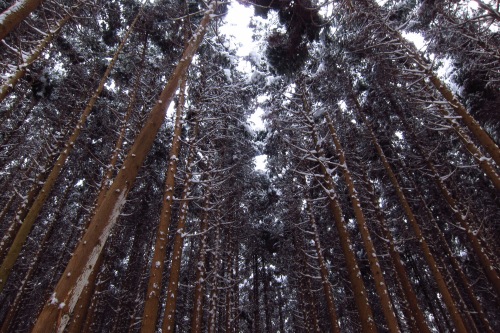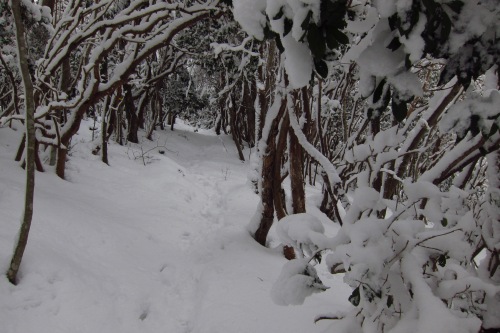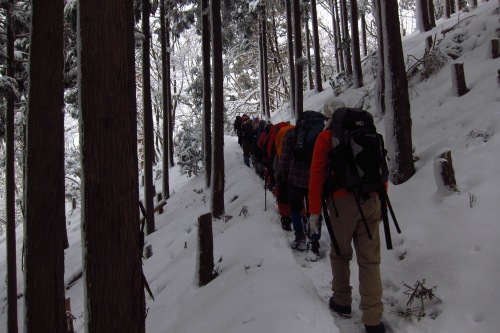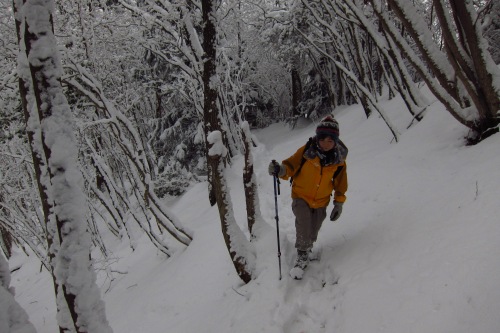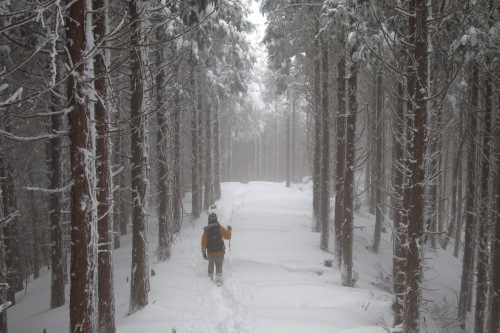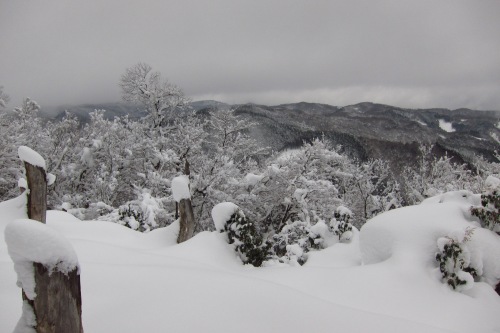February is always a quirky month for weather. While most of the time the temperatures hover close to freezing, there are always a few warm days sprinkled in as a teaser for spring. One such window presented itself in late February, and passing up such an opportunity to lighten up the clothing load was not an option. It was time to check another peak off the Kansai 100 list, but which one? None of the remaining 10 looked feasible as a day trip unless planning was precise. Mt. Eboshi immediately came to mind, but it would be a formidable challenge to complete the tough slog before nightfall.
Mt. Eboshi is situated near the southern tip of the Kii Peninsula, a one-way distance of roughly 3-1/2 hours from Osaka by fastest train. The peak sits behind Mt. Nachi, one of a trio of mountains known as the Kumano Sanzan, and overlooks Nachi waterfall, the tallest fall in Japan. The waters flow through a constricted gorge on the upper reaches of the watershed and drop uninterrupted for 133 meters to the valley floor. This is one of the holiest places in the Kii Peninsula, drawing scores of shugenja pilgrims throughout the centuries before the large temple was torn down during the Meiji era.

I arrived at Kii-katuura station at 11:30am after the long train journey and immediately hailed a taxi. Precious minutes could not be wasted on waiting for the next bus: I needed to be on the trail an hour ago as it was. There are several approaches to Mt. Eboshi, but from the map it appeared that the shortest route lie through Higashi-no-tani (東ノ谷) just to the west of my target peak. The taxi driver dropped me off at a parking lot that overlooked a bridge crossing the Nachi river. Pointing his finger, he signaled that I would find the route after crossing the bridge. Paying up, I thanked him and shouldered for the long ascent.

After crossing the bridge, the route ended in an enormous construction zone with signs forbidding entry. Fortunately, there was a small area to the left where I could work my way through the tangled mess of excavators and dump trucks. Looks like Nachi is about to become the home of some more unnecessary concrete dams. Luckily the construction zone was only down towards the river, and higher up the creek bed I left civilization and entered what looked like a war zone. Head-high boulders were strewn throughout the bed: the water was barely flowing through this outlet, so it is hard to fathom the amount of rainfall required to turn this trickle into a torrent.

The map indicated that a well-maintained path would take me to the base of Inyo falls (陰陽の滝), but all I found were strips of pink tape affixed to trees and red arrow marks painted on the boulders. Occasionally I would see sections of the path still clinging to the side of the bank, but most of the wooden walkways were washed away. The destruction here was some of the worst I’d ever seen nature impart, and later research revealed that this was indeed caused by the typhoon of September 2011 which I also witnessed during the ascent of Mt. Yahazu. One brave blogger visited Inyo falls just one month after the typhoon and offered these scenes. From the looks of things, it may be some time before the trail is fully rebuilt, with the Japanese government placing priority on making the rivers ‘safe’ first.

The pink tape led me up through the destruction zone, but the path was up to my own intuition. Scrambling, ducking, hopping, and squeezing were all executed to perfection, but this obstacle course was also eating into precious time. Eventually I did reach Inyo falls, where the path became much easier to pick out, but not much simpler to navigate. A series of river crossings ensued, with each becoming trickier to pick up. Signposts were few and far between, and even with the GPS I struggled to navigate the constricted gorge. The only thing on my side was the weather: I was down to short-sleeves and the water was tepid due to the mild temperatures, making the inevitable slips into the stream more bearable.

Higher and higher I rose, double checking landmarks with both the GPS and the paper map. After ninety minutes of endless climbing, Matuo waterfall presented itself in all its glory. The water flowed down a thick rock slab like a wedding veil dropping from the cranium of a new bride. The end of the climb was in sight, or so I thought.

Twenty minutes after scaling past the last waterfall, the trail terminated at a dirt forest road ringed by rows of cedar trees. It never fails to amaze me how these forest workers can built roads into such inaccessible places. I stopped for a brief lunch, trying to fuel up for the final climb. I still had 300 meters of vertical elevation and 40 minutes until the summit. It was 2pm and I needed to be up by 2:30 if I wanted to make it back before dark.

I pushed on, traversing as the trail climbed steeply towards the ridge. Ropes made the tricky footwork more manageable. Through gaps in the trees I spied a towering boulder jutting out of an adjacent peak. This must surely be Uboshi rock, I thought, and knowing that the summit was now in view gave me a much-needed boost. After hitting the ridge, the path climbed straight up towards the right edge of boulders, with more ropes in place to aid in the fight against gravity. I reached the top of the rock and turned right for several more minutes of ascending until finally popping out on the high point at 2:30pm.

The summit itself was eclipsed by trees, but a small gap to the north offered vistas into Takada village at the base of a series of rolling mountains flanking the Kumano Kodo. Mt. Eboshi is one of the Shin Hyakumeizan, and someone with a sense of humor had scratched out the Shin (新) kanji so it appeared as if Eboshi were on the list of 100 Famous Mountains. While it is a fine peak, I couldn’t help feeling disappointed to do all of that climbing only to be met by a forest road.

I did not linger long on the summit, retracing my steps to the base of Eboshi rock. There’s a ladder and chains in place for people to climb the rock, so I indulged myself by resting on the slab and taking in the excellent views out to the Pacific Ocean. This would be an amazing place for a bivouac in good weather. Perhaps future climbers can heed my advice if they dare to follow my footsteps.
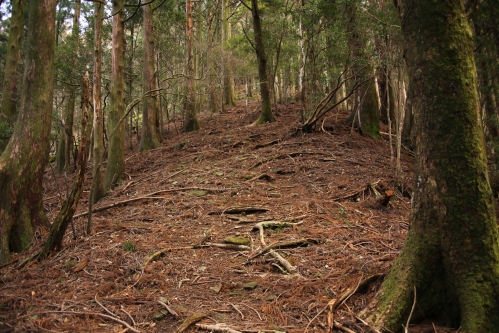
My original plan was to retrace my steps back into Higashi-no-tani, but the state of the trail had me abandon that option and aim for Hontani (本谷), the headwaters of Nachi falls. I retreated back to the forest road and continued heading west, past the junction for Higashi-no-tani and into the unknown. The road was washed out in several places and after 15 minutes of walking I found a poorly-marked trail shooting off into the forest on my left. I cross-referenced with the GPS and dropped down into a creek bed lined with cedar trees. This creek shot me out onto another dirt forest road which I mistakenly followed up the valley for several minutes until realizing my error. Back to the junction I retreated, eventually picking up the path again after a bit of frantic searching. Here I offer some advice to the Wakayama Prefectural Government: spend less time building roads to nowhere and more time marking your trails clearly. This is supposedly a World Heritage site after all.

The dense forest blocked out the light, giving amble warning that nightfall would soon be approaching. I picked up the pace, flowing past a series of other streams flowing in from both the right and left. Eventually I reached San-no-taki (三の滝), where the trail climbed up steeply to the base of an enormous cryptomeria tree nearly a thousand years old. Just on the other side of this giant, a series of stone steps as old as the trees led me to the base of Ni-no-tani (二の谷) with its emerald green pool. I paused here, taking in the scenery and refueling the body. San means ‘three’ in Japanese, while ni is for ‘two’, so where is waterfall number one? A quick study of the map revealed the answer, for I was sitting just a short distance from the top of Nachi falls, the first waterfall. Now it all started to make sense, as in the old days the esoteric monks would climb up here and perform their aesthetic rituals at all three waterfalls. Legend has it that some of them would even leap over the 133 meter drop of waterfall number one in the ultimate path to spiritual awakening.

Nowadays, visitors are forbidden from entering the area above Nachi falls, as that’s the domain of the gods. There is a shimenawa rope strewn across the falls, so I’m sure that plenty of shrine staff come up here to restring the rope from time to time. From here, there was one final steep climb up a series of stone steps to a mountain pass that revealed views down to the shrine near the base of the falls. The end was finally in sight. A few minutes later, I found myself at the 3-storied pagoda overlooking the falls. The final step in my trip was to find the bus stop.

I followed the signs as best I could, but after one false turn I ended up at the top of Daimon-zaka, a stone-lined hill situated along the Kumano Kodo. I had come here just two months after my heart surgery and fondly remember climbing this slope with Kanako. Since I knew there was a bus stop at the bottom, I simply went down Daimon-zaka. This is one of the most popular parts of the Kumano Kodo, as day-trippers can easily make it up here to the falls and back before heading back to their hot spring hotels along the coast. However, on this late afternoon on a cloudy Monday, there was no one around to spoil the scenery. It was the ideal way to end the hike, and I arrived at the bus stop at 5pm, with just 15 minutes to spare before the bus back to Kii-katsuura and the final train back to Osaka at 6pm.

It was an epic adventure, but not one I want to repeat anytime soon. I’m getting too old for these kind of things, and I really just want to get the last 9 peaks finished so I can start leading a more relaxing life and devoting time to raising a family. Am I finally growing up after all these years?
